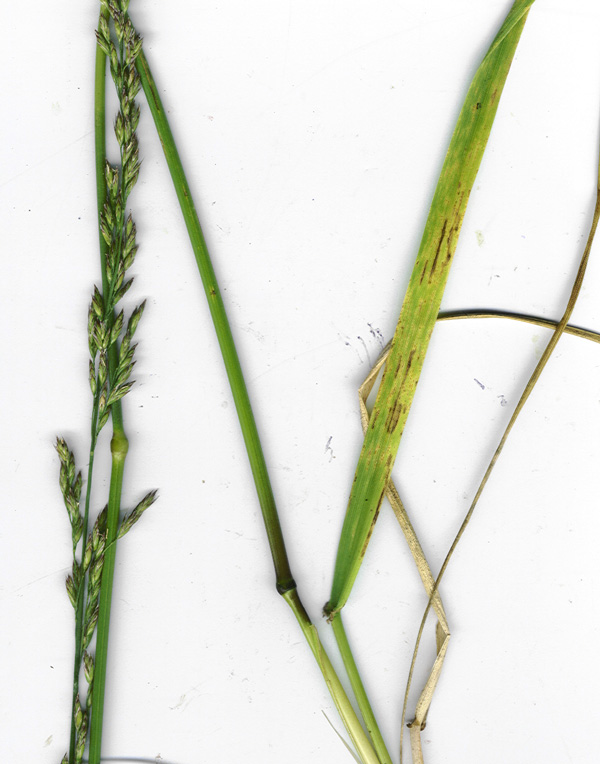
Karen J. McDowell, MS, PhD, a researcher at the University of Kentucky Gluck Equine Research Center, provided the following information on fescue toxicosis in non-pregnant horses. Fescue was imported from Europe in the early 1800s, and it can be found in nearly every state. While a very adaptable grass, the fungus that infects the plant can cause problems in pregnant and non-pregnant animals of various species, including horses. Following is a report on her ongoing research.
Tall fescue (Lolium arundinaceum) is a perennial grass adapted to much of the eastern half of the United States and widespread in the Central Ohio Valley, including Kentucky. Much of the tall fescue contains a fungus, called an endophyte, which, together with the fescue plant, produces chemicals called ergot alkaloids that can be harmful to grazing animals. The best known of these ergot alkaloids is ergovaline.
Fescue toxicosis in horses is most frequently associated with hormonal changes in late gestation mares, causing gestation lengths to extend beyond expected due dates. It is also associated with thickened placentas and abnormal placental separation when birth occurs, as well as with dystocia (difficult birth) and agalactia (lack of milk production by the dam).
In cattle, the most frequently reported signs of fescue toxicosis are associated with vasoconstriction (blood vessel constriction). This can result in cattle overheating in the summer because they cannot dissipate heat effectively and sometimes causes signs of gangrene in the winter due to insufficient blood flow to the hooves or tail switch. Fescue toxicosis in cattle is also associated with low average daily gain, poor growth rates, and lowered fertility. Reports in the literature of whether grazing endophyte-infected fescue can cause poor growth rates or reduced performance or fertility rates in horses are inconsistent, and researchers have not investigated the mechanisms that might contribute to these effects.
Therefore, several years ago, the laboratory of Karen McDowell, PhD, associate professor at the University of Kentucky Gluck Equine Research Center, performed some experiments to determine if endophyte-infected fescue caused vasoconstriction in horses, similar to cattle.
McDowell, along with Laurie Lawrence, PhD, professor in UK’s Department of Animal and Food Sciences, fed horses ground fescue seed containing either fescue seed containing ergovaline and associated alkaloids or alkaloid-free fescue seed. They used Doppler ultrasonography to measure blood flow in, and the diameter of, the palmar artery in each horse’s left foreleg, just above the fetlock joint. They found significant artery constriction in animals consuming alkaloid-infected fescue seed but not in animals consuming alkaloid-free seed. This was the first known report of endophyte-infected fescue causing vasoconstriction in horses consuming it, and the results appeared in the Journal of Animal Science (J. Anim. Sci. 2013. 92:1677. doi:10.2527/jas2012-5852).
Next, McDowell’s laboratory set out to investigate if mares consuming endophyte-infected fescue seed had altered blood flow to their ovaries. This experiment was part of the Master of Science degree of Drew Hestad, MS, who is currently attending veterinary school at Auburn University. Again, the research team fed mares either fescue seed containing ergovaline and associated alkaloids or alkaloid-free fescue seed. Each of 12 mares received non-infected seed for one complete estrous cycle and infected seed for another complete estrous cycle. Mares receiving the infected seed had palmar artery and palmar vein constriction and, importantly, reduced blood flow in the corpus luteum, the structure on the ovary that produces the hormone progesterone. This was the first report of infected fescue causing reduced blood flow to the ovaries in mares.
This spring, McDowell, along with Glen Aiken, PhD, from the USDA Forage Animal Production Unit located on UK’s campus, and Michael Barrett, PhD, and Tim Phillips, PhD, both from UK’s Department of Plant and Soil Sciences, will examine vasoconstriction and pregnancy outcomes in pregnant mares grazing fescue grass containing a novel endophyte. This grass produces alkaloids that give the grass the same competitive advantage over other forage grasses, but without the harmful alkaloids.
Although endophyte-infected fescue’s deleterious health effects in mares have previously only been associated with problems in late gestation, this recent work demonstrates that endophyte-infected fescue can cause vasoconstriction in the legs and reduced blood flow to reproductive organs in mares. Researchers have yet to determine these effects’ significance on growth, performance, fertility, or other physiological parameters. However, McDowell believes the use of Doppler ultrasonography to monitor palmar artery diameter in horses grazing endophyte-infected tall fescue pastures might provide a convenient and noninvasive biomarker to determine premonitory signs of fescue toxicosis, and she is continuing work in this area.


